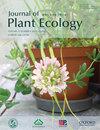无除草剂条件下抗草甘膦转基因甘蓝型油菜和野生甘蓝型油菜二、六代回交的适应度
IF 3.9
2区 环境科学与生态学
Q2 ECOLOGY
引用次数: 0
摘要
摘要转基因作物的转基因基因能否成功导入野生或杂草亲缘植物取决于携带该转基因基因的回交代的适合度。为了更好地评价转基因甘草甘膦油菜与野生甘草甘膦油菜基因流的生态风险,本研究对转基因甘草甘膦油菜与野生甘草甘膦油菜在低密度(5株/m2)和高密度(10株/m2)、单栽与混栽(野生甘草甘膦油菜:BC1F2R-BC1F6R=1∶1)条件下的第2代至第6代回交(BC1F2R-BC1F6R)的适合度进行了研究。分析了回交后代适合度成分与种植密度和种植方式的相关关系。在低密度单作条件下,较早世代BC1F2R和BC1F3R的组合适合度较低,较晚世代BC1F4R至BC1F6R的组合适合度较高。在高密度条件下,无论是单栽还是混栽,回交代的综合适合度均低于芥菜。相关分析表明,种植密度和格局对回交第2代至第6代(BC1F2R-BC1F6R)的适合度成分均有显著影响。从栽培型甘蓝型油菜向杂草型甘蓝型油菜的转基因渗入的可能性很大程度上取决于它们回交后代的特定生长条件。本文章由计算机程序翻译,如有差异,请以英文原文为准。
Fitness of the First Backcross Generations from the Second to the Sixth Progenies of Glyphosate-resistant Transgenic Brassica napus and Wild Brassica juncea in Absence of the Herbicide
Abstract Successful introgression of a transgene from a transgenic crop into a wild or weedy relative is determined by the fitness of backcross generations carrying the transgene. To provide insight for ecological risk assessment of gene flow between transgenic B. napus and wild B. juncea, this study investigated the fitness of the first backcross generations from the second to the sixth progenies (BC1F2R-BC1F6R) between glyphosate-resistant transgenic B. napus and wild B. juncea at low density (5 plants/m2) and high density (10 plants/m2) , and monoculture and mixed planting (wild B. juncea : BC1F2R-BC1F6R=1: 1 ). Correlations between the fitness components of backcross progeny, planting density and planting patterns were analyzed. In monoculture at low density, compared to B. juncea, earlier generations BC1F2R and BC1F3R had lower composite fitness, while later generations from BC1F4R to BC1F6R were more fit. At high density, whatever monoculture or mixed planting, all backcrossed generations had lower composite fitness than B. juncea. Correlation analysis indicated that both planting density and pattern significantly affected the fitness components of the first backcross generations from the second to the sixth progenies (BC1F2R-BC1F6R). That the probability of transgene introgression from cultivated B. napus to weedy B. juncea is likely to be highly contingent on the specific growing conditions of their backcross descendants.
求助全文
通过发布文献求助,成功后即可免费获取论文全文。
去求助
来源期刊

Journal of Plant Ecology
生物-植物科学
CiteScore
4.60
自引率
18.50%
发文量
134
审稿时长
3 months
期刊介绍:
Journal of Plant Ecology (JPE) serves as an important medium for ecologists to present research findings and discuss challenging issues in the broad field of plants and their interactions with biotic and abiotic environment. The JPE will cover all aspects of plant ecology, including plant ecophysiology, population ecology, community ecology, ecosystem ecology and landscape ecology as well as conservation ecology, evolutionary ecology, and theoretical ecology.
 求助内容:
求助内容: 应助结果提醒方式:
应助结果提醒方式:


